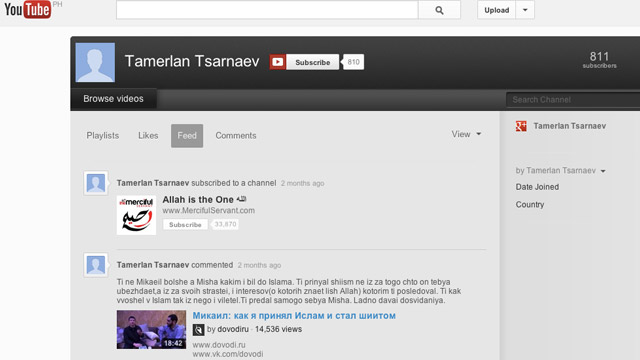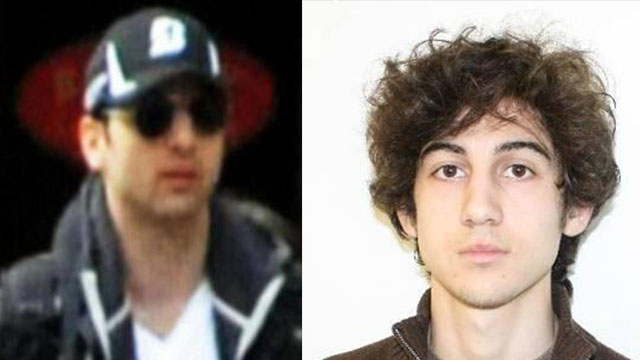SUMMARY
This is AI generated summarization, which may have errors. For context, always refer to the full article.
 26 year old Tamerlan Tsarnaev, one of the Boston bombing suspects killed in a shootout Friday, had at least one thing in common with the Abu Sayyaf in the Philippines: they spread an apocalyptic prophecy that foretells the triumph of Islam and is a secret motivation of al-Qaeda. Its symbol: the black flag, according to former FBI agent Ali Soufan, uniting and leading an all-powerful Islamic military force that will rise up from Central Asia and defeat the infidels.
26 year old Tamerlan Tsarnaev, one of the Boston bombing suspects killed in a shootout Friday, had at least one thing in common with the Abu Sayyaf in the Philippines: they spread an apocalyptic prophecy that foretells the triumph of Islam and is a secret motivation of al-Qaeda. Its symbol: the black flag, according to former FBI agent Ali Soufan, uniting and leading an all-powerful Islamic military force that will rise up from Central Asia and defeat the infidels.
It’s based on what they believe is a hadith or a saying of the prophet Mohammed: “If you see the black banners coming from Khurusan, join that army, even if you have to crawl over ice; no power will be able to stop them, and they will finally reach Baitul Maqdis [Jerusalem], where they will erect their flags.”
The video of the dramatization of the Black Banners of Khurusan is in Tamerlan Tsarnaev’s YouTube channel – only one of the clips supporting fundamentalism and violent jihad that he watched and spread.
Osama bin Laden’s 1996 declaration of war against the United States ends with the dateline, “Friday, August 23, 1996, in the Hindu Kush, Khurusan, Afghanistan.”
At the anniversary of the 9/11 attacks in 2012, black flags were raised in Libya after the killing of 4 Americans, including Ambassador Christopher Stevens. On that day, violent protests erupted in more than 20 countries. Black flags were raised by angry mobs in Egypt, Tunisia and Yemen. Soon after, authorities in the Philippines recovered the black flag from an Abu Sayyaf camp.

Another video in his social media account is a lecture by Feiz Muhammad, a fundamentalist Australian cleric and ex-boxer based in Malaysia: in one, he focused on the evil “paganism” of the Harry Potter movies.
Tamerlan’s YouTube playlist also included a song called “I Dedicate My Life to Jihad,” and the brothers were apparently influenced by the online Inspire magazine, which disseminates ideological materials and bomb-making techniques (including how to make the pressure cooker bombs used in Boston).
AQAP greatest threat to US?
Inspire is published by AQAP, al-Qaeda in the Arabian Peninsula. “AQAP is a direct extension of Central al-Qaeda,” said Rohan Gunaratna, author of Inside al-Qaeda and head of the International Center for Political Violence & Terrorism Research. “In many ways, the center of gravity of terrorist operations have shifted from al-Qaeda Central, led by Ayman al-Zawahiri, to al-Qaeda in the Arabian Peninsula. This group today poses the most significant threat to the US.”
Based in Yemen, AQAP was behind numerous foiled plots against the United States: the “underwear bomb” used to try to take down Northwest Flight 253 in 2009 and the “printer bombs” in a cargo bomb plot in 2010. In mid-2012, US authorities used a CIA sting operation to foil an AQAP plot to bomb US-bound airplanes with bombs hidden in the bodies of terrorists.
American Anwar al-Awlaki, head of AQAP’s external operations, was Inspire’s original publisher and a “master in the use of the Internet.” Although he was killed in a controversial drone strike by the US in 2011, his messages continue to resonate and win recruits online.
Video clip of black flag on Tsarnaev’s YouTube channel
The Internet has become a conduit for what I called the jihadi virus in my book, FROM BIN LADEN TO FACEBOOK. That shows how the virulent ideology behind al-Qaeda and its associate groups is spreading like a medical contagion.
More than a decade after 9/11, al-Qaeda has been decapitated, its top and middle-rank leaders gouged out of the social network that systematically spread the jihadi virus, but the cells below them continued to recruit leading to the radicalization of home-grown terrorists like Tamerlan and his 19 year old brother, Dzokhar. Ironically, Dzokhar became a US citizen on September 11, 2012, the day the black flags spread across the world and the anniversary of al-Qaeda’s iconic 9/11.
“The Internet today is the principal medium of communication by terrorists and extremist groups,” said Rohan Gunaratna. “We have seen a number of extremist groups that’s using the net to reach out to their supporters – to radicalize, to recruit people, to indoctrinate them and to get them to launch terrorist attacks.”
Watch full interview with Rohan Gunaratna taped just hours after the shooting and explosions at MIT.
The Tsarnaev brothers match the profile that most worries American law enforcement: long-time American residents familiar with American culture, geography and customs with ethnic roots and values that allow them to develop deep connections to Islamic movements overseas.
Homegrown like Madrid and London bombers
Much like the Madrid bombings in 2004 that killed 191 people and the London bombings in 2005 that killed 52, the Boston bombings were carried out by men who integrated into their societies and benefited from the liberalism and inclusiveness of the West. Yet, despite their seemingly Western ways, the attackers in London and Madrid harbored deep hatred sparked by al-Qaeda’s virulent ideology – perhaps much like Tamerlan, who said, “I don’t have a single American friend. I don’t understand them.”
The Madrid bombers had strong ideological links to al-Qaeda but had minimal overseas training and direction for the attacks. The London bombers communicated with al-Qaeda masterminds, who trained and directed them from Pakistan.
Tamerlan may have gone beyond radicalization on the Internet, where he could’ve learned how to make the pressure cooker bomb stuffed with ball-bearings and metal shards first used in Pakistan. The details are still emerging, but he may also have gotten training on the ground.
In 2011, a Russian security agency asked the FBI to interview Tamerlan Tsarnaev about suspected extremist or terrorist activity. Nothing much came of it.
On January 12, 2012, Tamerlan flew from New York to Moscow, the target of Chechen rage – a Muslim war linked to bin Laden’s global jihad. He didn’t return until 7 months later.
As more details about what drove the Tsarnaev brothers emerge, the Boston bombings show other affinities to the old al-Qaeda: the indiscriminate killing of civilians on a symbolic day – April 15 is both tax day and Patriots’ Day, marking the first battles of the American revolution. What’s clear is that the brothers were familiar with Boston and the Marathon’s symbolic significance.

These photographs released by the FBI are a stark contrast from the photos slowly filtering out from shocked family and friends. There, we see them in better times.
They are smiling, handsome young men with hatred in their hearts, fanned and fuelled by the Internet to carry out terrorist attacks.
These are the faces of the terrorist threat today. – Rappler.com
Maria Ressa has been a journalist in Asia for nearly 30 years. She’s the author of “From bin Laden to Facebook: 10 Days of Abduction, 10 Years of Terrorism” and “Seeds of Terror: An Eyewitness Account of al-Qaeda’s Newest Center of Operations in Southeast Asia.”
Related Stories:
From Chechnya to Boston: How the threat spreads
Add a comment
How does this make you feel?
There are no comments yet. Add your comment to start the conversation.